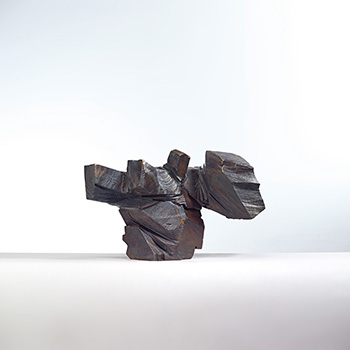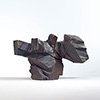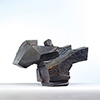Catalogue Note:
In contemporary Chinese artistic circle, Ju Ming's sculpture arts are famous for the style containing deep orient cultural connotation and presenting personality. In his sculpture "Taichi" series, the individual sculpture together with the surrounding environment, has formed a unique humanistic landscape. In "Taichi Series", taking basic skills of shadowboxing as the elements of traditional picture for shaping and further replacing the traditional connotation in it, applying the massive touch sense and concise patch sense of modern sculpture, Ju Ming, as an artist, has expressed his understanding on imago of mutual integration and accommodate ion of Chinese and western cultures.
Taichi is an important symbol forming Ju Ming's mature sculpture language and artistic style. When Taichi appeared by his cutting skills, it immediately aroused the concern from international artistic circle. The creation theme "Taichi" is originated from his life experience, as well as an experience of life movement and a capture of life imago also. Ju Ming accepted Yuyu Yang's suggestion and begun to learn shadowboxing. Exercise of shadowboxing and comprehension about shadowboxing spirit has evolved into a new topic of his sculptural art, as well as his personality. The works have presented an immense bearing of man and nature combination and promoted the outstanding existence of "Taichi" image. From learning Taichi to carving Taichi, along with increasing improvement of skills of Taichi, his understanding about Taichi spirit has been continuously deepened, images he carved coming out one after another so that his creation turning to be more and more confident and perfect, attaining such a realm where he "carves at will", oblivious of himself.
In 1978, Ju Ming went to Japan for exhibitions twice. That was the first time his "Taichi Series" attracted attention, among which, Single Whip has, since then, found its foothold in Japanese Chokoku no mori. "Taichi Series" opened another foreground of his creation also. Actually, before then, in the exhibition of 1976 through which he found fame, Ju Ming had exhibited a woodcarving with the topic of Kong Fu, which could be considered as the origin of the "Taichi Series". But, in the view of Ju Ming, it is the "Taichi Series" that is the starting point of his own style. He expresses the vital force from inside to outside rather than from outside to inside.
In the sculptures of the "Taichi Series", the relations between the geometric abstraction and active posture of the figures, as well as the contrast between the dynamic and static, the rough and terse in tri-dimensionality form a rich rhythmic change in the works. The sculpture presents a very colorful effect of change between light and shadow. In "Single Whip", relying on his own experience and judgment, Ju Ming made artistic treatment of the familiar Taichi culture and relevant boxing skills, having broken away from previous and relevant frame, giving out a kind of vitality and irresistible power.
Ju Ming's creation of the "Taichi Series" has made mutual reference and integration of the sculpture on a shelf and the environmental sculpture and introduced a new concept of modern sculpture, endowing modern public space with a wider visual creation and humanistic prospect. With its unique visual symbol and sculptural graphic arts, the "Taichi Series" has become a complementation of an urban life and an extension of natural creation. The works have shaped a visual effect of conquering the dynamic by static and exciting touch sense, being provided with a specific impelling force of the age and teemed with endless imagination and edification of a contemporary aesthetic spirit.
Taichi Series, executed in 1991 depicting the posture “Below Elbow Watch First Lean", is an exercise in freeform fluidity. Both hands move to the front, gathering energy inwards for an explosive kick with the right foot. This is the right heel kick, boiled down to its bare essence. In this piece, you can truly appreciate the explosive power of the heel kick along with the solid stability of the left foot, a great example of the principles of perfect balance in Taichi. As Ju Ming said "the practice of Taichi strives for a concentration of energy on the inside, along with calm and ease on the outside ".
Taichi is an important symbol forming Ju Ming's mature sculpture language and artistic style. When Taichi appeared by his cutting skills, it immediately aroused the concern from international artistic circle. The creation theme "Taichi" is originated from his life experience, as well as an experience of life movement and a capture of life imago also. Ju Ming accepted Yuyu Yang's suggestion and begun to learn shadowboxing. Exercise of shadowboxing and comprehension about shadowboxing spirit has evolved into a new topic of his sculptural art, as well as his personality. The works have presented an immense bearing of man and nature combination and promoted the outstanding existence of "Taichi" image. From learning Taichi to carving Taichi, along with increasing improvement of skills of Taichi, his understanding about Taichi spirit has been continuously deepened, images he carved coming out one after another so that his creation turning to be more and more confident and perfect, attaining such a realm where he "carves at will", oblivious of himself.
In 1978, Ju Ming went to Japan for exhibitions twice. That was the first time his "Taichi Series" attracted attention, among which, Single Whip has, since then, found its foothold in Japanese Chokoku no mori. "Taichi Series" opened another foreground of his creation also. Actually, before then, in the exhibition of 1976 through which he found fame, Ju Ming had exhibited a woodcarving with the topic of Kong Fu, which could be considered as the origin of the "Taichi Series". But, in the view of Ju Ming, it is the "Taichi Series" that is the starting point of his own style. He expresses the vital force from inside to outside rather than from outside to inside.
In the sculptures of the "Taichi Series", the relations between the geometric abstraction and active posture of the figures, as well as the contrast between the dynamic and static, the rough and terse in tri-dimensionality form a rich rhythmic change in the works. The sculpture presents a very colorful effect of change between light and shadow. In "Single Whip", relying on his own experience and judgment, Ju Ming made artistic treatment of the familiar Taichi culture and relevant boxing skills, having broken away from previous and relevant frame, giving out a kind of vitality and irresistible power.
Ju Ming's creation of the "Taichi Series" has made mutual reference and integration of the sculpture on a shelf and the environmental sculpture and introduced a new concept of modern sculpture, endowing modern public space with a wider visual creation and humanistic prospect. With its unique visual symbol and sculptural graphic arts, the "Taichi Series" has become a complementation of an urban life and an extension of natural creation. The works have shaped a visual effect of conquering the dynamic by static and exciting touch sense, being provided with a specific impelling force of the age and teemed with endless imagination and edification of a contemporary aesthetic spirit.
Taichi Series, executed in 1991 depicting the posture “Below Elbow Watch First Lean", is an exercise in freeform fluidity. Both hands move to the front, gathering energy inwards for an explosive kick with the right foot. This is the right heel kick, boiled down to its bare essence. In this piece, you can truly appreciate the explosive power of the heel kick along with the solid stability of the left foot, a great example of the principles of perfect balance in Taichi. As Ju Ming said "the practice of Taichi strives for a concentration of energy on the inside, along with calm and ease on the outside ".


